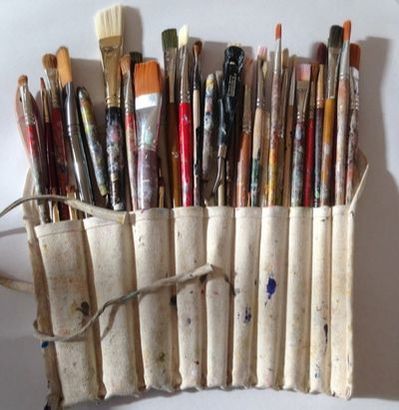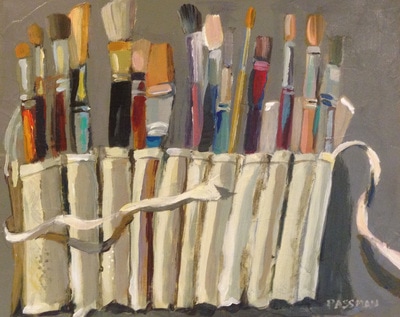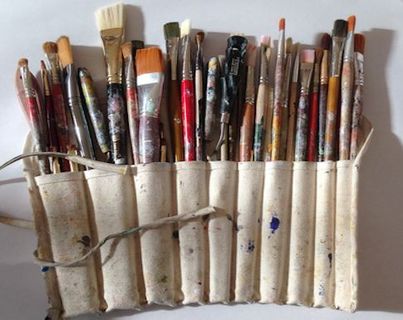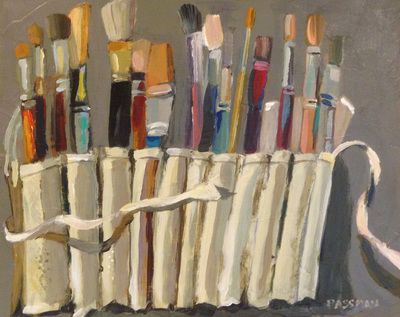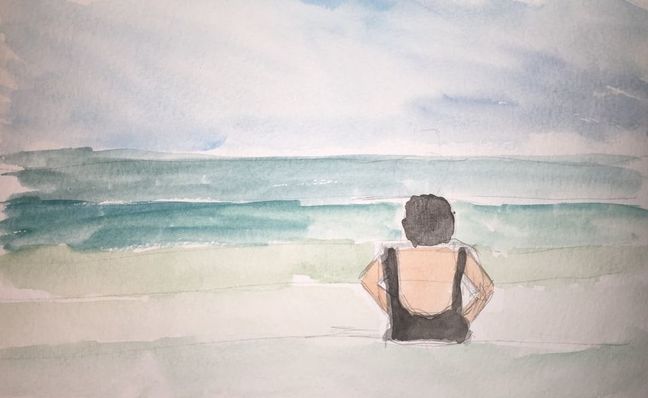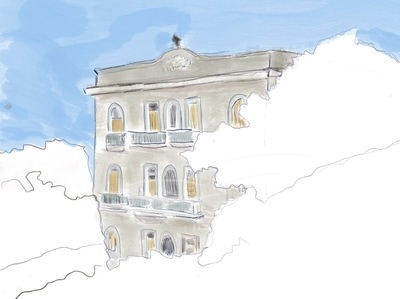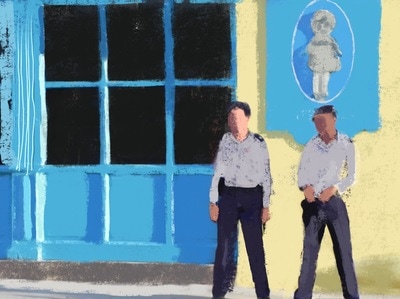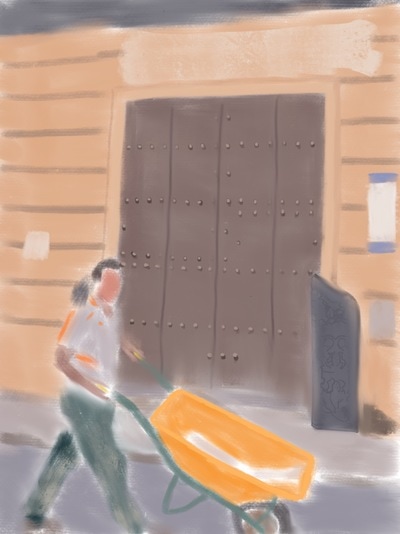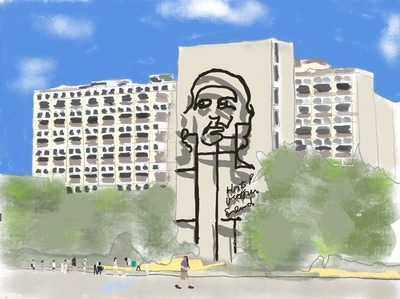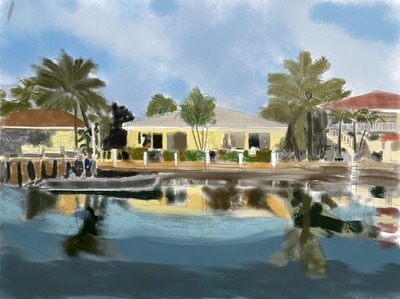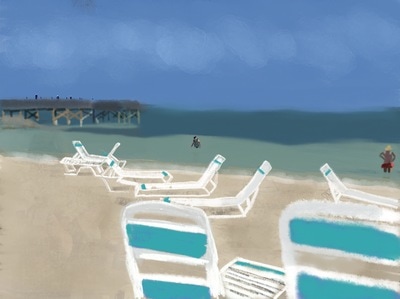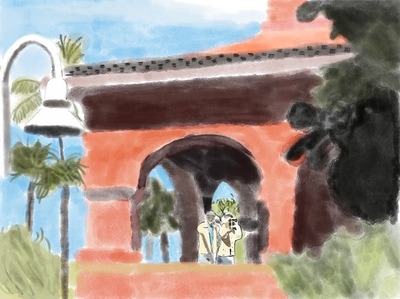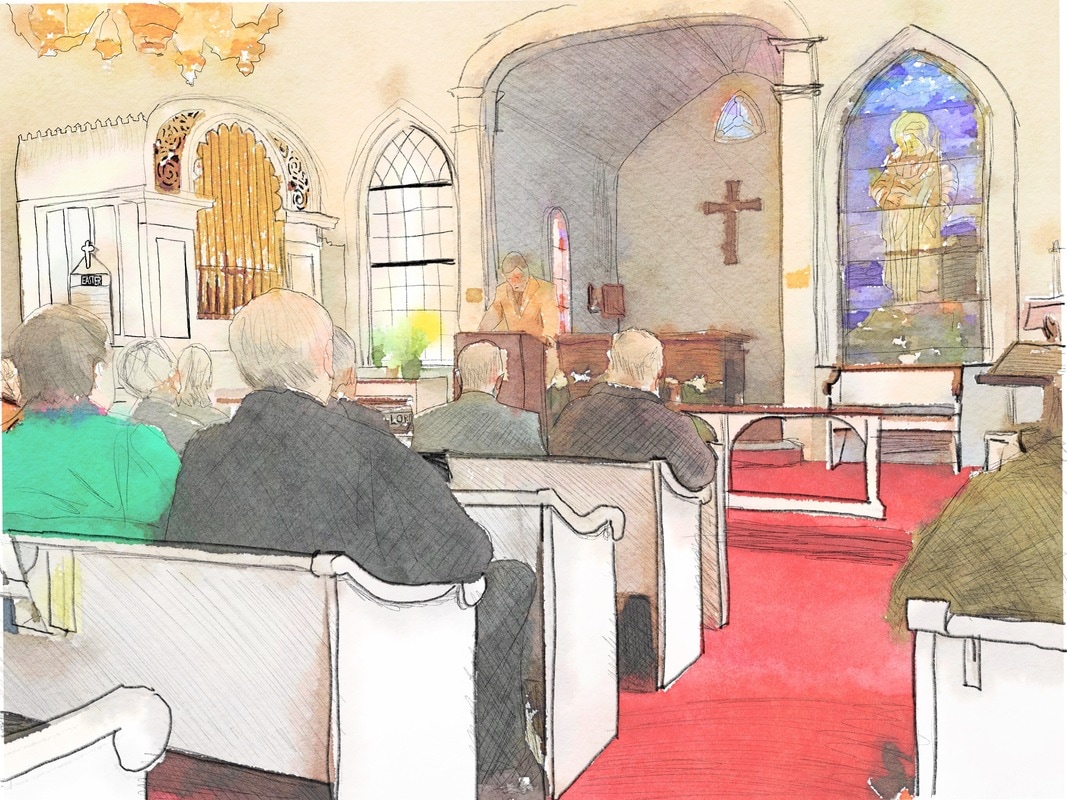Art and Technology |
July 1, 2017
|
For a long time I have loved artistic expression. Although a fan of many different types of art, I am particularly drawn to sketching and watercolor paintings.
For the past 5 years I have tried more seriously to produce sketches and watercolors -- with varying success. I do not seem to have a real talent for looking at a scene and being able to reproduce a likeness. I realize it does take a lot of time to master a skill. People ask me when I figure out how to solve a problem with their computer "How did you know how to do that?" I respond: "I've been practicing for 40 years for this moment."
Well, the same kind of concentration is required to produce good art, but I just don't have another 40 years to get as good at drawing and painting as I am at computers. And furthermore, I do indeed have an innate talent when it comes to computers, and I had discovered that I don't have the same talent when it comes to sketching freehand renderings of a scene. I struggle whenever I try, and perfectionist that I am, I get discouraged.
[Note: Last Saturday, after I originally wrote most of this article, I went over to the studio of Emily Passman, an artist who lives in Lexington -- and from whom I have taken classes in watercolor sketching in the past. After looking at Emily's work again, I'm not so sure about my approach, and I am rethinking the role of computers in my final versions of drawings and paintings. I'm not so inclined to giving up on my own freehand sketching versus some of the techniques I describe below. I still do think the computer tablet with a good electronic pencil that senses pressure and angle has a lot to offer an artist. I think the best approach to using the new technologies is some hybrid mixed approach. As an example of the difference between an entirely technical approach to art versus a freehand artistic expression unencumbered by technology, I present two illustrations lifted from Emily's website (emilypassman.com):
For the past 5 years I have tried more seriously to produce sketches and watercolors -- with varying success. I do not seem to have a real talent for looking at a scene and being able to reproduce a likeness. I realize it does take a lot of time to master a skill. People ask me when I figure out how to solve a problem with their computer "How did you know how to do that?" I respond: "I've been practicing for 40 years for this moment."
Well, the same kind of concentration is required to produce good art, but I just don't have another 40 years to get as good at drawing and painting as I am at computers. And furthermore, I do indeed have an innate talent when it comes to computers, and I had discovered that I don't have the same talent when it comes to sketching freehand renderings of a scene. I struggle whenever I try, and perfectionist that I am, I get discouraged.
[Note: Last Saturday, after I originally wrote most of this article, I went over to the studio of Emily Passman, an artist who lives in Lexington -- and from whom I have taken classes in watercolor sketching in the past. After looking at Emily's work again, I'm not so sure about my approach, and I am rethinking the role of computers in my final versions of drawings and paintings. I'm not so inclined to giving up on my own freehand sketching versus some of the techniques I describe below. I still do think the computer tablet with a good electronic pencil that senses pressure and angle has a lot to offer an artist. I think the best approach to using the new technologies is some hybrid mixed approach. As an example of the difference between an entirely technical approach to art versus a freehand artistic expression unencumbered by technology, I present two illustrations lifted from Emily's website (emilypassman.com):
In the first on the left, we see a photograph of a set of brushes in a traditional cloth carrier. On the right, we see Emily's rendition probably using acrylics of what she saw. I find the right rendition far more attractive than the left. If I were to use some of the techniques below, it would be possible, but more difficult to achieve the same transformations the artist's eye has introduced here -- the compression of the vertical dimension in particular. Was this transformation intentional? I think now -- rather it is Emily's unconscious / artistic sense to do things like decreasing the length of the cloth carrier, shorten the length of the brushes so that the interesting parts are highlighted, etc.
It's not that some artistic transformations can't be made using technology, it's just that they are not as easy to add spontaneously. For example, the transformation that went on in Emily's mind to change the aspect ratio of her drawing was probably not something she explicitly thought about. But seeing what she did is easy to do inside a photo editor:
It's not that some artistic transformations can't be made using technology, it's just that they are not as easy to add spontaneously. For example, the transformation that went on in Emily's mind to change the aspect ratio of her drawing was probably not something she explicitly thought about. But seeing what she did is easy to do inside a photo editor:
So, take what I say below with the caution that I don't quite believe everything I say. I think my techniques will help me over the hump of being pleased with my work and being able to produce something that isn't embarrassing. However please understand that my desire is to be a better freehand sketcher and painter. And with today's longer lifespans, perhaps at age 69, I do have enough years ahead of me to master a different skill.
As a final point to this discussion about the advantages of freehand artistic expression over computer mediated expression, my favorite sketch from a recent trip to the Florida Keys is one I did in about 10 minutes of my wife Marsha sitting on the beach looking out over the water. I did this with a pencil and then with a small watercolor kit and a single waterbrush on a postcard sized piece of watercolor paper. It has the spontaneity that I wish all of my sketches had.
As a final point to this discussion about the advantages of freehand artistic expression over computer mediated expression, my favorite sketch from a recent trip to the Florida Keys is one I did in about 10 minutes of my wife Marsha sitting on the beach looking out over the water. I did this with a pencil and then with a small watercolor kit and a single waterbrush on a postcard sized piece of watercolor paper. It has the spontaneity that I wish all of my sketches had.
.... however, here are a couple of other sketches I made with various techniques on my iPad in January and February of 2017 that I am also pleased with. Click on small image to see larger view:
Over the years I have various computer programs that transform photographs in one way or another. Some programs like Photoshop are used to tune a photograph -- to adjust the exposure, correct colors, crop the photograph to the important part, etc. Graphic artists use various illustration programs to combine parts of photos and scanned drawings with display text and background colors to produce attractive brochures, flyers, and posters.
Recently, developers have created "filters" that can be applied to photographs to create intentional distortions to a photograph, primarily in the area of color to produce attractive derivative photographs. The Instagram app on smartphones and tablets was one of the first successful programs that many people experienced with such capabilities. Although these transformations were first developed for laptop and desktop computers, it was Instagram that bundled a lot of such transformations into one integrated program. With the various transformations in Instagram, people could not only share photographs, but they could put a small amount of their artistic interpretation of the scene that they photographed.
Once such photo transformations gained acceptance and smartphones and tablets proliferated, the market was wide open for all sorts of developments in photo transformations, from putting picture frames around photographs and various stupid additions (in my opinion) of butterflies, stars and hearts. But along with the trivial transformations came one type of transformation that appealed to me: complex transformations that could take a photograph and introduce some of the effects that a human artist introduces when looking at a scene and reproducing what s/he sees using sketching and painting media. So, for example, programs to transform a photograph into a pencil sketch started to appear.
This is a good time to stop and ask, "What is the difference between a photograph and a painting?" I have thought about this a lot and have concluded that the most important thing an artist introduces when s/he produces a painting are the departures from reality -- that is what makes a painting or drawing different. Many time these departures are "mistakes" -- a momentary tremor in the hand of a person sketching a line causing the line not to be absolutely straight. Or the color on a watercolor brush not being exactly the same as in the actual scene. Or the obvious lack of detail in the faces of people in a crowd in the background of a painting with a main subject. Or, the intentional distortion by an artist in painting a Cubist masterpiece. It is these imperfections that make a painting or sketch attract our attention.
Recently, developers have created "filters" that can be applied to photographs to create intentional distortions to a photograph, primarily in the area of color to produce attractive derivative photographs. The Instagram app on smartphones and tablets was one of the first successful programs that many people experienced with such capabilities. Although these transformations were first developed for laptop and desktop computers, it was Instagram that bundled a lot of such transformations into one integrated program. With the various transformations in Instagram, people could not only share photographs, but they could put a small amount of their artistic interpretation of the scene that they photographed.
Once such photo transformations gained acceptance and smartphones and tablets proliferated, the market was wide open for all sorts of developments in photo transformations, from putting picture frames around photographs and various stupid additions (in my opinion) of butterflies, stars and hearts. But along with the trivial transformations came one type of transformation that appealed to me: complex transformations that could take a photograph and introduce some of the effects that a human artist introduces when looking at a scene and reproducing what s/he sees using sketching and painting media. So, for example, programs to transform a photograph into a pencil sketch started to appear.
This is a good time to stop and ask, "What is the difference between a photograph and a painting?" I have thought about this a lot and have concluded that the most important thing an artist introduces when s/he produces a painting are the departures from reality -- that is what makes a painting or drawing different. Many time these departures are "mistakes" -- a momentary tremor in the hand of a person sketching a line causing the line not to be absolutely straight. Or the color on a watercolor brush not being exactly the same as in the actual scene. Or the obvious lack of detail in the faces of people in a crowd in the background of a painting with a main subject. Or, the intentional distortion by an artist in painting a Cubist masterpiece. It is these imperfections that make a painting or sketch attract our attention.
I have experimented with all of these types of computer enhancements / transformations to digital photographs for almost 20 years -- starting with photographs from my first Sony Mavica digital camera in 1997 -- I have experimented with lots of programs to transform photographs. During this time, I have also taken many classes in more traditional fine arts including sketching, drawing and watercolor that did not involve computers or photographs. But as I struggled to master the start of any drawing or painting, the sketch of the various objects in the scene, I kept asking myself "Why am I struggling to figure out where lines from my pencil or pen go on the paper when I know how to produce an excellent sketch using computer processing of a photograph -- a photograph of a scene into which I have put artistry into the selection of the scene and the angle of the shot."
But, I haven't given up on my traditional art lessons because I continue to learn the techniques and skills of traditional drawing and painting, which I find is very useful in using today's tools to produce pieces of art that I like. I have discovered that bringing the techniques of traditional drawing and painting with me as I use computer and camera based tools to allow me to produce drawings and paintings that please me.
I have discovered programs that do all of the work in transforming photographs into paintings are nowhere near as interesting to me as programs where I can use a stylus on a touch sensitive screen to interactively draw lines and paint areas perhaps with reference to a photograph for the placement of features, or the color of an object or background.
Last year I purchased an Apple iPad Pro and an Apple Pencil which allows me to draw directly on a large surface. The Apple Pencil can sense both the pressure I apply to the surface and the angle at which I am holding the pencil relative to the surface. At the same time I started using a program called ProCreate on the iPad as the main drawing tool. ProCreate allows me to manage many different layers that when overlaid produce the full image. Thus, I can start with a photograph, and place a blank layer above it on which I sketch lines that define the objects in the scene I am drawing/painting. ProCreate provides me with many different pencils, pens and brushes along with a full spectrum of colors -- including colors drawn directly from the bottom photograph layer. I can place the background colors and washes on a separate layer, and then put the sketch on top of the background layer as I add more details, such as the face in a portrait, or the hair, or clothes -- each on their own layer. This multi-layer approach makes it possible to experiment to see what will happen if I add this feature, without the worry of ruining the painting. The opacity of layers can be adjusted permitting, for example, the ability to control the intensity of outlines from very light to very dark.
I am still learning how to use this new medium and technique to produce drawings and paintings. I have stayed with the look of watercolors, but with ProCreate, I could move to another (simulated) style of painting. There are many things I can do with a real brush and watercolor paints that I haven't figure out how to do in ProCreate. I have seen examples of work done using ProCreate on an iPad that look very close to what a good watercolor artist can do. We'll see how this goes.
Here is an example of a sketch I developed last week using ProCreate. Here is the Facebook post I wrote about this drawing and the event at which I made it.
But, I haven't given up on my traditional art lessons because I continue to learn the techniques and skills of traditional drawing and painting, which I find is very useful in using today's tools to produce pieces of art that I like. I have discovered that bringing the techniques of traditional drawing and painting with me as I use computer and camera based tools to allow me to produce drawings and paintings that please me.
I have discovered programs that do all of the work in transforming photographs into paintings are nowhere near as interesting to me as programs where I can use a stylus on a touch sensitive screen to interactively draw lines and paint areas perhaps with reference to a photograph for the placement of features, or the color of an object or background.
Last year I purchased an Apple iPad Pro and an Apple Pencil which allows me to draw directly on a large surface. The Apple Pencil can sense both the pressure I apply to the surface and the angle at which I am holding the pencil relative to the surface. At the same time I started using a program called ProCreate on the iPad as the main drawing tool. ProCreate allows me to manage many different layers that when overlaid produce the full image. Thus, I can start with a photograph, and place a blank layer above it on which I sketch lines that define the objects in the scene I am drawing/painting. ProCreate provides me with many different pencils, pens and brushes along with a full spectrum of colors -- including colors drawn directly from the bottom photograph layer. I can place the background colors and washes on a separate layer, and then put the sketch on top of the background layer as I add more details, such as the face in a portrait, or the hair, or clothes -- each on their own layer. This multi-layer approach makes it possible to experiment to see what will happen if I add this feature, without the worry of ruining the painting. The opacity of layers can be adjusted permitting, for example, the ability to control the intensity of outlines from very light to very dark.
I am still learning how to use this new medium and technique to produce drawings and paintings. I have stayed with the look of watercolors, but with ProCreate, I could move to another (simulated) style of painting. There are many things I can do with a real brush and watercolor paints that I haven't figure out how to do in ProCreate. I have seen examples of work done using ProCreate on an iPad that look very close to what a good watercolor artist can do. We'll see how this goes.
Here is an example of a sketch I developed last week using ProCreate. Here is the Facebook post I wrote about this drawing and the event at which I made it.
|
Harry Forsdick
April 23 at 8:00am · Yesterday, Marsha Baker and I attended the Hilltown Chautauqua in Ashfield, MA. This is a sketch I made of this a twice a year meeting where serious topics are considered from a 360º perspective using lectures, art, dance, musical performance, dramatic performance, etc. to inform our understanding. Last Fall, the topic was ecology, yesterday, the topic was "Civitas", understanding the underpinnings of our discourse. To quote David Perkins the founder and organizer of the Hilltown Chautauqua, "The working assumption of this program: When you're confused and dispirited about where you are going, it helps to know where you've come from." You can find out more information about this organization at www.hilltownchautauqua.org. |

